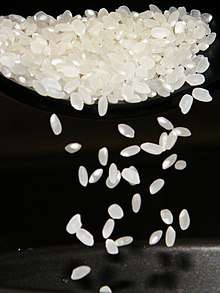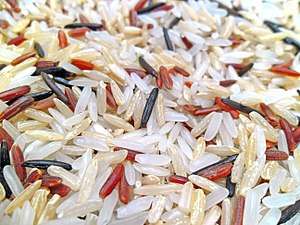Koshihikari
| Koshihikari | |
|---|---|
 | |
| Hybrid parentage | 'Nourin No.1' × 'Nourin No.22' |
| Subspecies | O. s. subsp. japonica |
| Cultivar group | temperate japonica |
| Cultivar | Nourin No.100 (Etsunan No.17) |
| Marketing names | Koshihikari |
| Origin | Japan, 1956 |
Koshihikari (Japanese: コシヒカリ, 越光 Hepburn: Koshihikari) is a popular variety of rice cultivated in Japan as well as Australia and the United States.
Koshihikari was first created in 1956, by combining 2 different strains of Nourin No.1 and Nourin No.22 at the Fukui Prefectural Agricultural Research Facility. It has become very popular now in Japan, in part due to its good appearance. It is one of the most highly grown varieties of rice in the country, and its taste is said to differ per region.
Etymology
The character for koshi (越) is used to represent the old Koshi Province, which stretched from present-day Fukui to Yamagata. Koshihikari can be translated as "the light of Koshi".
Related varieties
Other rice varieties close to its strains, such as Akitakomachi, Hitomebore, and Hinohikari have been created afterwards by cross-breeding Koshihikari with other Japanese varieties of rice.
Characteristics
- Highly susceptible to blast disease
- Its stem collapses easily when mature
See also
External links
- JA Uonuma Minami (Japanese) JA branch in South of Uonuma area in Japan
